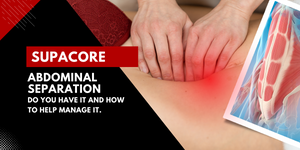Recovery from abdominal separation
What is abdominal separation?
Abdominal separation is also known as Diastasis Recti or “DRAM” (Diastasis of rectus abdominis muscle) and is the separation of the large abdominal muscles. These muscles run down the of the stomach, from chest to pelvis.
This type of separation is extremely common during and directly after pregnancy, usually developing in the second half of pregnancy, especially in women who have had more than one child, those who are having twin or triplets, or women with a small frame and a larger than average baby.

What causes abdominal separation?
Although abdominal separation is something that cannot be prevented or predicted, there are a few factors, combined, that can contribute to the separation of those abdominal muscles:
- the pressure of your growing baby during pregnancy
- stretching of the muscles and connective tissue in your abdomen
- the hormonal changes that take place during pregnancy.
- weight gain.

What are the symptoms?
There are a few signs and symptoms that one can look out for to signal abdominal separation. These include:
- A bulge in the lower stomach
- Poor posture
- Lower back pain
- Bloating
Post partum symptoms may include seeing a ridge or gap in between the two muscles. A way to check if you might have abdominal separation after birth is to;
- Lay flat on your back, legs bent and both feet flat on the floor.
- Slightly raise shoulders and support your head with one hand.
- Use your other hand to feel any gaps between the muscles, below the belly button. A gap larger than one or two fingers may indicate diastasis recti.
To receive a proper diagnosis, seek medical advice from your GP, midwife or physiotherapist.
What should I avoid doing?
Until fully healed, there are a few things that you can do to avoid further damage or pain.
Traditional exercises like situps, crunches, spinal extensions (like back bends) and plank positions should be avoided. Strenuous activities or exercises, lifting or carrying heavy loads, holding your baby on your hip ….these activities can cause widening of the muscles, putting pressure and strain on the already weakened area resulting in pain in the abdomen and lower back.

What recovery options are there?
There are a couple of things that can be done to improve and treat abdominal separation. Practicing good posture and good nutrition can assist in the ease of strengthening those muscles. Usually suggested 6 weeks postpartum, lightweight exercises are recommended to strengthen those muscles, along with wearing compressive garments to help support your muscles and pelvis.
Good posture & good nutrition
Keeping a conscious thought on posture will go a long way in the improvement of your diastasis. Remember that no amount of physical exercise can outperform bad posture.
One thing to keep in mind when trying to heal postpartum is what foods make an impact on the repair of the body. Foods rich in protein and zinc such as fish, meat, nuts, beans and eggs have had a proven record when it comes to healing. Vitamin A found in foods such as kale, broccoli and sweet potato is also considered a staple in a healing body, Plenty of water is highly urged to maintain healthy bowel habits.
Lightweight exercises
The most common exercises that one can implement are as followed:
Low impact water activities such as swimming, water aerobics, or deep water running.
Biking, walking and step classes are also something that are suitable for more movement implementation.
Isolated exercises like glute bridges, assisted squats or side planks from knees can be beneficial.
Compression
Compression can be worn during pregnancy to support the lower back and your growing baby bump. It is best to check with your physician as to the level of compression that can be worn.
After birth, this is where compression shorts are at their most effective. Compression on the abdomen helps to encourage the separated abdomen to recover and return to their original placement.
General benefits of utilising a compression postpartum include:
- Pain relief
- Increased blood flow
- Healing of muscles and wounds
- Lowers swelling after surgery
- Assists with posture
- Encourages and helps get you moving again
Compression shorts or leggings should be worn for 8-10 weeks after delivery, although they can still be worn for as long as they provide benefit to healing and recovery.
With any injury Supacore encourages specialist medical advice for each individual case.
How can Supacore help?
Supacore has 2 products that can help support you during your pregnancy and post pregnancy:
Supacore’s patented shorts are promoted, recommended and endorsed by the Australian Chiropractic Association, and approved by TGA health safety regulations. They are listed as a certified medical device and may be claimed for a rebate depending on your level of health cover.
These shorts can be worn under any outfit, keeping you in place and protected while you get back to doing what you love.
REFERENCE LIST :
Australia, Healthdirect. “Abdominal Separation (Diastasis Recti).” www.pregnancybirthbaby.org.au
16 Dec. 2020, pregnancybirthbaby.org.au/abdominal-separation.
Chertoff, Jane. “Diastasis Recti: What Is It, and How Is It Treated?” Healthline, Healthline Media, 20 Nov. 2017, www.healthline.com/health/diastasis-recti#outlook
Dubin, Alesandra. “Diastasis Recti Exercises: Do’s and Don’ts for Your Postpartum Pooch.” Parents, 2021, www.parents.com/pregnancy/my-body/postpartum/diastasis-recti-exercise-dos-and-donts/
Exercise Right. “What Is Diastasis Recti (Abdominal Separation)?” Exercise Right, 8 May 2017, www.exerciseright.com.au/abdominal-separation/
Mota, Patrícia Gonçalves Fernandes da, et al. “Prevalence and Risk Factors of Diastasis Recti Abdominis from Late Pregnancy to 6 Months Postpartum, and Relationship with Lumbo-Pelvic Pain.” Manual Therapy, vol. 20, no. 1, Feb. 2015, pp. 200–205, 10.1016/j.math.2014.09.002.
O’Donovan, Sinead. “7 Reasons Why You Must Have Postnatal Recovery Shorts.” Best in Australia, 11 Nov. 2020, www.bestinau.com.au/reasons-why-you-must-have-postnatal-recovery-shorts
Our Fit Family Life. “Diastasis Recti Ab Exercises | Abdominal Separation Workouts.” OUR FIT FAMILY LIFE, www.ourfitfamilylife.com/diastasis-recti-exercise
“What Is a Postpartum Belly Wrap?” WebMD, www.webmd.com/parenting/what-is-postpartum-belly-wrap#1

